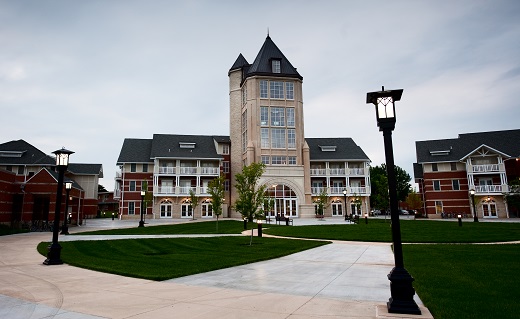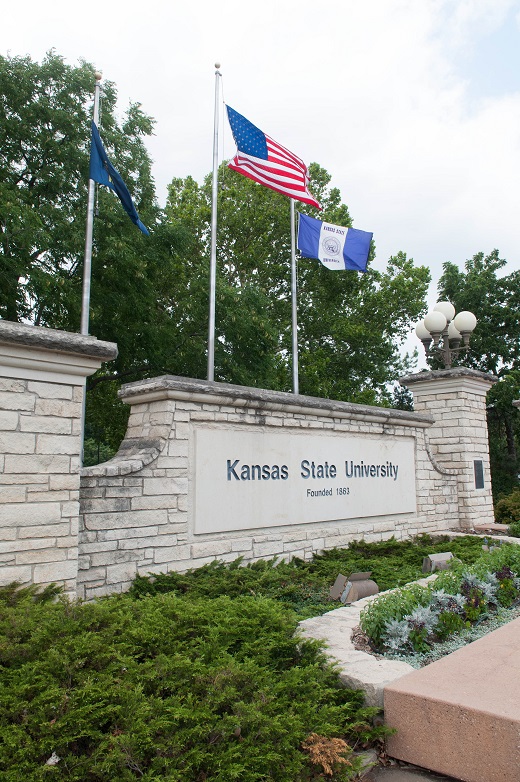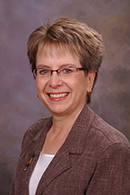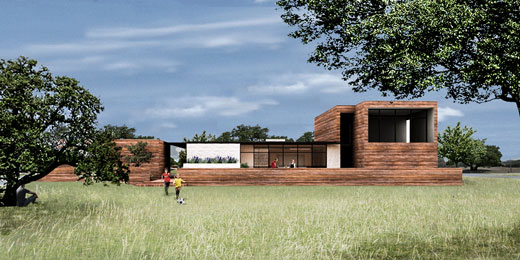09/30/20
K-State Current - September 30, 2020
K-State Current is a weekly news update for the Kansas Board of Regents to apprise the Regents on a few of the many successes and achievements made by K-State faculty, staff and students.
K-State News
The place to be: K-State among Top 10 best employers in Kansas
 When it comes to the best employers in Kansas, an annual survey by Forbes magazine finds Kansas State University rates among the Top 10 in the state and is the best university employer in the Sunflower State.
When it comes to the best employers in Kansas, an annual survey by Forbes magazine finds Kansas State University rates among the Top 10 in the state and is the best university employer in the Sunflower State.
K-State comes in at No. 9 on Forbes' "America's Best Employers by State List" for Kansas. Moreover, K-State is the only university to be ranked among the state's Top 25 best employers.
The university's greatest resource is its faculty and staff, who make K-State a great place to work, said Jay Stephens, vice president for Human Capital Services. As an employer, Stephens said the university's mission is to provide progressive, responsive and innovative solutions to attract, retain, develop and reward a highly talented, diverse and inclusive K-State community that cultivates an environment where students and employees flourish.
"K-State strives to provide excellence in recruiting, developing and retaining a diverse, highly qualified workforce," Stephens said. "Along with an unmatched sense of community and inclusiveness, K-State provides employees with a variety of benefits, including health care, retirement options, discounted event tickets and much more."
For the list, Forbes and Statista, a marketing research company, surveyed 80,000 workers from businesses with at least 500 employees. The rolling survey was conducted from October 2019 to May 2020 and in all 50 states and the District of Columbia. In the anonymous surveys, employees rated their employers on a variety of criteria, including safety of work environment, competitiveness of compensation, opportunities for advancement and openness to telecommuting. Workers also were asked if they would recommend their employers to others.
Read more at forbes.com/best-employers-by-state/#17ce21b5487a.
K-State Libraries dean to retire in May 2021
 Longtime Dean of K-State Libraries Lori Goetsch is ready to start the next chapter in her life: retirement. Goetsch's last day will be May 28, 2021.
Longtime Dean of K-State Libraries Lori Goetsch is ready to start the next chapter in her life: retirement. Goetsch's last day will be May 28, 2021.
"I would like to thank Dean Goetsch for her outstanding service to Kansas State University, particularly in the last two years as she steered the university through the aftermath of the Hale Library fire to overseeing its renovation and transformation as a next-generation library," said Charles Taber, provost and executive vice president. "Her leadership has been truly appreciated during this time as has her work to ensure the university libraries' mission of assisting academic success in research, learning and discovery."
During her tenure as dean since August 2004, Goetsch has guided K-State Libraries through many challenges, most notably the May 2018 fire at Hale Library that led to the building's closure for 15 months. Goetsch was tasked with overseeing the recovery process and then leading the planning and renovation to turn Hale into a next-generation library.
"I think my greatest accomplishment and the one that was most unexpected was the Hale fire and our recovery," Goetsch said. "I learned so much about a lot of things — general contracting, interior design, architecture, insurance — it was quite an experience and one I'm very proud of. We will have a beautiful and functional Hale Library for many years to come."
Goetsch calls the fire and its aftermath the most challenging experience of her career.
"I think I have persevered because I wanted to give back something to K-State that can be a point of pride," Goetsch said. "I thought about retiring earlier, then the fire happened and it just didn't feel right to bail out at that point. I needed to see it through and I wanted to be part of making our vision for the new library a reality."
The Hale recovery and her other successes as dean would not be possible, Goetsch said, without the staff of the K-State Libraries, which include Hale Library, the Math/Physics Library and the Paul Weigel Library of Architecture, Planning and Design.
"I want to acknowledge the great staff of the K-State Libraries," she said. "They are a service-oriented, hard-working, creative group that has a strong commitment to the K-State community. They've made it through the fire and are now doing the same with COVID-19. I admire their resilience and persistence."
The timing of Goetsch's retirement coincides with the completion of the Hale Library renovation, which is slated for January 2021.
"I want a few months to enjoy and appreciate the building and the effort it took to get us to completion," Goetsch said. "Then it seems like a good time to ride off into the Kansas sunset. I will definitely miss, most of all, the great people at K-State."
Before coming to K-State, Goetsch served as director of the public services division at the University of Maryland's library, head of reference services and associate professor at the University of Tennessee, women's studies bibliographer, librarian and head librarian for information-reference at Michigan State University, and assistant reference librarian at the University of Illinois at Chicago.
As a researcher, Goetsch's published work covers a range of topics, including the importance of library safety and security, the impact of librarians on students, faculty and staff and their accomplishment of the libraries' missions, as well as the status of women in librarian positions in relevance to sex discrimination in employment.
She also has been active in several professional organizations, including the American Library Association; board member of the Greater Western Library Alliance, State Library of Kansas and the Emporia University School of Library and Information Management; president of the Association of College and Research Libraries from 2009 to 2010 and also serving on its board; and an executive member of Humanities Kansas.
Among Goetsch's many honors are receiving a National/International Diversity in the Curriculum grant, Michigan State University Libraries Distinguished Librarian Award and selection to the Association of College and Research Libraries/Harvard Leadership Institute in 2000.
Goetsch earned bachelor's and master's degrees in English from Illinois State University and a Master of Library Science from Rosary College, now Dominican University.
A search for Goetsch's replacement will begin in the near future with additional details forthcoming.
K-State Faculty Highlights
Civil engineering assistant professor named White House Fellows national finalist
 Eric Fitzsimmons, assistant professor and the Hal and Mary Siegele professorship in engineering,
Eric Fitzsimmons, assistant professor and the Hal and Mary Siegele professorship in engineering,
Kansas State University Department of Civil Engineering, has a new certificate to frame and display — 2020 - 2021 White House Fellows national finalist. While ultimately not selected, Fitzsimmons did successfully complete all three rounds of the stringent application process.
Founded in 1964 by Lyndon B. Johnson, the White House Fellows program is one of America's most prestigious programs for leadership and public service. White House Fellowships offer exceptional young men and women firsthand experience working at the highest levels of the federal government.
The initial round of more than 1,000 applicants began in January with requirements to answer six essay questions and submit a federal policy proposal to the president. Fitzsimmons also submitted support letters from faculty and administration at Kansas State University; administration at the University of Kansas; division directors at the National Academies of Sciences, Engineering and Medicine; and active and retired law enforcement personnel from Alexandria, Virginia, and Jacksonville, Florida.
His proposed policy to the president, "Increasing Police Officer Recruitment and Retention Through Establishment of a Community Peace Officer Network," involved reorganizing and expanding the U.S. Department of Justice's Community-Oriented Policing Services Program to develop a congressional-supported, line-item, federal-funded non-firearm-carrying Community Peace Officer Network.
Fitzsimmons said he had applied for the fellowship to better understand public service by potentially working and interacting with individuals at the highest levels of government and then hoped to translate that experience into better serving and leading at Kansas State University and the state of Kansas through public service or in an administrative role.
As a national finalist, Fitzsimmons went through an extensive security clearance process and participated in "selection weekend," which included three evenings and two days of interviews with members of the President's Commission on White House Fellowships. After spending the weekend interviewing, interacting with, and observing the national finalists, the commissioners recommended individuals to the president for appointment as White House Fellows.
"My plan is to reapply and go through the interview process again for the 2021-2022 White House Fellowships," he said, "now knowing firsthand the rigors and demands required of the interview process. The unforgettable conversations and interactions with other national finalists from around the U.S. in areas outside of engineering, as well as the commissioners, was worth it."
Other notable national finalists and White House Fellows from Kansas include former Kansas governor and U.S. senator, Sam Brownback; former Kansas Gov. Jeff Colyer; U.S. Rep. Sharice Davids; former U.S. secretary of transportation, and of Labor, as well a U.S. senator from North Carolina, Elizabeth Dole; and former U.S. representative and current U.S. secretary of state, Mike Pompeo.
National Science Foundation awards grant for Smart and Connected Communities project
 Hyung Jin Kim, associate professor in the landscape architecture and regional & community planning department at Kansas State University's College of Architecture, Planning & Design, or APDesign, recently received a $150,000 grant from the National Science Foundation for the Smart and Connected Communities project.
Hyung Jin Kim, associate professor in the landscape architecture and regional & community planning department at Kansas State University's College of Architecture, Planning & Design, or APDesign, recently received a $150,000 grant from the National Science Foundation for the Smart and Connected Communities project.
Kim will serve as lead principal investigator working with K-State faculty members George Amariucai, computer science, and Bala Natarajan, electrical and computer engineering, on a pilot study and workshop for enriching rural-to-urban disaster resilience by integrating social, spatial and digital networks.
The social networks that comprise our local communities can be critical for helping individuals, households and businesses respond, overcome and recover from natural disasters such as floods. Traditionally these networks are based on direct and indirect face-to-face interpersonal relationships often clustered within geographically defined communities. In the digital era, however, we have seen the rapid transformation of social networks challenging traditional notions of community and our understanding of the roles community-based social networks play in disaster situations. If digital technologies play a crucial role in facilitating a new wave of social networking, how might these networks augment and enhance more community-based networks' response to disasters? Will people and households use their traditional community or geographical-based versus digital/virtual networks in disaster contexts? To what extent do these networks overlap and reinforce each other? And, what kinds of infrastructure can and should, be built to create an augmented social-spatial-online network system for disaster resilience?
The Smart and Connected Communities project will conduct an interdisciplinary investigation into multilayer social networking patterns for information dissemination in disaster situations overlaying social, geographical and digital networks and organize a multistate community-engaged workshop that will help build a framework for evaluating the infrastructure needs and robustness of augmented social networking for digitally and geographically disconnected communities. The project will target rural to urban communities in several Midwest U.S. watershed regions in Kansas, Missouri and Nebraska that have been frequently affected by natural disasters.
The results of the pilot study will be shared, evaluated and refined through a series of community interactions, including community workshops and direct research engagements. Ultimately, this project will catalyze new research collaborations within the STEM workforce in the underserved disaster-prone U.S. communities that can help develop interdisciplinary technological innovations for building augmented social networking systems enhancing disaster response and resilience in the United States.
Kim's area of research interest is in the intersections between environmental design, social environment and people's behaviors situated in diverse community contexts from rural to urban. Kim seeks opportunities to accelerate interdisciplinary innovations on the built environment research.
"This National Science Foundation grant recognizes Dr. Kim's expertise in planning for cities of the future and establishes an interdisciplinary research team that will contribute to the disaster resilience of communities in Kansas and beyond," said Stephanie Rolley, department head in landscape architecture and regional & community planning. "Community-engaged research is a foundation of our department and college."
The NSF Smart and Connected Communities program aims to accelerate the creation of the scientific and engineering foundations that will enable smart and connected communities to bring about new levels of economic opportunity and growth, safety and security, health and wellness, and overall quality of life. The program supports interdisciplinary research that synergistically integrates technological and social science dimensions for U.S. communities entering a new era of transformation through rapidly changing intelligent technologies.
K-State Student Highlights
APDesign graduate student earns honorable mention in international design competition
 Natalie Grimm, Highlands Ranch, Colorado, a fifth-year graduate student in architecture at Kansas State University's College of Architecture, Planning & Design, earned honorable mentions in the 2020 International Housing Design Student Competition, sponsored by the Association of Collegiate Schools of Architecture, or ACSA.
Natalie Grimm, Highlands Ranch, Colorado, a fifth-year graduate student in architecture at Kansas State University's College of Architecture, Planning & Design, earned honorable mentions in the 2020 International Housing Design Student Competition, sponsored by the Association of Collegiate Schools of Architecture, or ACSA.
The competition challenge given was to answer to a project client. In response to the pandemic, the client decided to permanently transfer their software company to a completely remote status. In light of this transition, the client needs a space in their new home that is dedicated to work and provides adequate privacy and sound isolation. In this workspace, the client wants a space that has the ability to seal itself off from the rest of the home, providing privacy and sanitation in the event of visitors. The client has a spouse and two children and would like a home where the ritual of sanitation is integrated into the everyday flow.
The home designed by Grimm is programmatically divided into four bars: sleeping, entertainment, sanitation and utility. The entertainment bar is expressed through a tectonic roof plane in contrast to the masslike construction of the sleeping and sanitation bars. These bars are further separated by transitional circulation spaces, creating layers of isolation as well as sanitation. The primary entrance for the homeowner is located through the sanitation bar on the public circulation axis. This entry to the home offers the first layer of sanitation: on the left there is a wet room, and to the right is the progression of food sanitation. The entertainment bar houses the kitchen, dining and living areas. It is then extended out into an exterior entertainment room that is open to the views of the greenbelt. A circulation bar provides a physical and sound barrier between the rest of the home and the sleeping bar. The sleeping bar is an area of rest and self-care, housing the bedrooms and fitness area.
The site is in the suburb of West Oak Hill in Austin, Texas. The site is on a corner lot, allowing for the home to respond to the prevailing winds throughout the seasons. To the north of the site, a greenbelt stretches across the neighborhood, providing the home with peaceful northern views. Austin is in a humid subtropical climate. The home uses local materials such as limestone and cedar for construction, capitalizing on mass construction for passive cooling.
Architecture professor and department head Matthew Knox was the faculty advisor for Grimm.
Comments from the jury included, "Grimm is receiving an honorable mention due to the sensitive use of regional materials and strong Modernist forms and spaces the students produced for the project."
